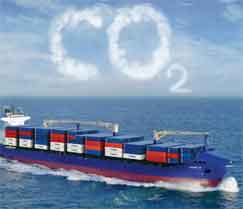When the Paris UN Climate Accord was approved by some 180 nations in 2015, the global shipping industry was largely left out of the picture.
Why?
The accord was focused on plans by individual countries to reduce their C02 emissions so that collectively, in theory, global temperatures would stay below the UN’s target rise in temperatures.
But bulk cargo and container carriers do their business sailing across oceans, with most of their time usually spent in international waters – outside of a connection to any particular country’s carbon emissions. So shipping was not addressed in the agreement.
That despite the fact that ocean cargo ships are estimated to produce about 3% of total global emissions – a significant share.
The International Maritime Organization (IMO) regulates global shipping, and a few years back passed a resolution affirming a goal to reduce greenhouse gas emissions from the sector by 50% by 2050 versus 2008 levels.
Such a target would be challenging enough just based on volumes, with global trade (despite a current slowdown) expected to rise substantially over time, meaning ocean carriers will need to decrease emission levels by much more than half per ship to meet the 2050 target, when factoring in volume growth.
The target gets even tougher given the fact carriers are not clear how to get there – and will face tens of billions of dollars of investment in a sector that has been struggling financially for many years.
 “The impact on shipping in terms of cost to protect the environment will be the biggest in history,” Kitack Lim, secretary-general of the IMO, said in an interview last month, as reported by the Wall Street Journal. “The impact on shipping in terms of cost to protect the environment will be the biggest in history,” Kitack Lim, secretary-general of the IMO, said in an interview last month, as reported by the Wall Street Journal.
Ships last for many years, sometimes as long as three decades or more. That means that ship owners will probably fight hard against rules that would force them to scrap ships early in their normal lifecycles.
That in turn means that to reach the targets, carriers and ship leasing firm will have soon to stop ordering vessels that are powered by so-called bunker fuel or new low sulfur diesel with new designs that will use wind, biofuels, ammonia, hydrogen, batteries or another alternative fuel.
And in the short term, ship owners have other concerns. Other IMO rules require that starting Jan. 1, 2020, ships must either begin using a much more low-sulfur diesel fuel instead of the “dirty” bunker fuel burned currently, or install expensive scrubber costs millions per ship to capture the sulfur from ship emissions.
Neither approach will do much to reduce CO2 emissions – and will involve as much as $15 billion in new annual costs that carriers hope to pass on to shippers, but with spotty success in doing so in the past with other spikes in the cost of fuel.
Some in the industry predict that depending on how this plays out, the change could force weaker carriers to go under. And all that before radical changes to reduce CO2.
And there are problems with all the alternative fuels.
Using wind through new age sails can reduce fuel consumption, but isn’t viable to fully power a vessel.
The Wall Street Journal reports that zero-CO2 emission-making ammonia at first seemed like a strong candidate. But converting ammonia into fuel is carbon-intensive, and global ammonia production capacity would have to be increase substantially to meet this new demand. Ammonia is also very toxic when mixed with water, which would cause big problems in case of a spill or accident.
Some carriers and shippers are testing battery-powered vessels, but only for short haul trips.
To be viable on long haul cargo ships, which produce most of the emissions, carriers would have to devote a lot of current cargo space to housing the batteries, and still more space to store the hydrogen fuel used to charge the batteries, changing ship economics.
The Wall Street Journal says Maersk and other operators have been looking at biofuels that can be derived from cooking oil and forest product residues. Those fuels still produce CO3, but 80% less than fuels currently used in internal combustion engines. But widespread deployment is uncertain and probably many years away, with use of bio-fuels for other applications such as powering cars progressing rather slowly.
“Over the next handful of years we have to [hone] in on exactly the right energy source for the future,” Søren Toft, chief operating officer of Maersk, told the Journal. “It has to be commercially viable and we have to get there.”
Do you see a path for the ocean shipping industry to significantly reduce CO2? What alternative fuel will win? Let us know your thoughts at the Feedback button below.

|